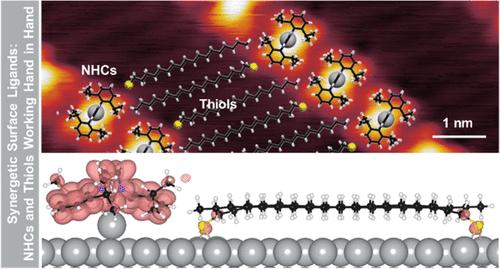当前位置:
X-MOL 学术
›
J. Am. Chem. Soc.
›
论文详情
Our official English website, www.x-mol.net, welcomes your
feedback! (Note: you will need to create a separate account there.)
Cooperative Use of N-Heterocyclic Carbenes and Thiols on a Silver Surface: A Synergetic Approach to Surface Modification
Journal of the American Chemical Society ( IF 14.4 ) Pub Date : 2024-11-15 , DOI: 10.1021/jacs.4c10521 Jindong Ren, Mowpriya Das, Yuxiang Gao, Ankita Das, Andreas H. Schäfer, Harald Fuchs, Shixuan Du, Frank Glorius
Journal of the American Chemical Society ( IF 14.4 ) Pub Date : 2024-11-15 , DOI: 10.1021/jacs.4c10521 Jindong Ren, Mowpriya Das, Yuxiang Gao, Ankita Das, Andreas H. Schäfer, Harald Fuchs, Shixuan Du, Frank Glorius

|
Surface modification through the formation of a self-assembled monolayer (SAM) can effectively engineer the physicochemical properties of the surface/material. However, the precise design of multifunctional SAMs at the molecular level is still a major challenge. Here, we jointly use N-heterocyclic carbenes (NHCs) and thiols to form multifunctional hetero-SAM systems that demonstrate excellent chemical stability, electrical conductivity, and, in silico, catalytic activity. This synergistic effect is facilitated by the high surface mobility and electron-rich nature of NHCs, combined with the strong binding strength of thiols. Scanning tunneling microscopy, electrical conductivity, and scanning electron microscope measurements, as well as density functional theory calculations, were employed to explore the synergistic interactions in the supramolecular SAMs. The van der Waals integration of ballbot-type NHCs and thiols enables the SAMs to exhibit both superior surface anticorrosion properties (attributing to the shift in the d-band center) and low surface resistance originating from the band alignment. Moreover, we find that the deposition sequence of flat-lying NHCs and thiols results in SAMs with different configurations, which can further tune the mechanistic pathway in silico in the acetylene hydrogenation process. Our results provide essential molecular insights into the local electronic control of the new SAM/metal interface and the high stability of the emergent multifunctionality (NHC/thiol)-SAMs forming self-assembled lamellae structures in the nanometer regime.
中文翻译:

N-杂环卡宾和硫醇在银表面上的协同使用:一种表面改性的协同方法
通过形成自组装单层 (SAM) 进行表面改性可以有效地设计表面/材料的物理化学性质。然而,多功能 SAM 在分子水平上的精确设计仍然是一个重大挑战。在这里,我们共同使用 N-杂环卡宾 (NHC) 和硫醇形成多功能异质 SAM 系统,该系统表现出优异的化学稳定性、导电性和计算机催化活性。NHC 的高表面迁移率和富电子性质以及硫醇的强结合强度促进了这种协同效应。采用扫描隧道显微镜、电导率和扫描电子显微镜测量以及密度泛函理论计算来探索超分子 SAM 中的协同相互作用。球型NHC和硫醇的范德华集成使SAM既具有优异的表面防腐性能(归因于d波段中心的偏移),又因波段对准而具有较低的表面电阻。此外,我们发现平躺的 NHC 和硫醇的沉积序列导致具有不同构型的 SAM,这可以进一步调整乙炔加氢过程中计算机中的机理途径。我们的结果为新 SAM/金属界面的局部电子控制以及新兴多功能 (NHC/巯基)-SAM 的高稳定性提供了重要的分子见解,这些 SAMs 在纳米范围内形成自组装的薄片结构。
更新日期:2024-11-16
中文翻译:

N-杂环卡宾和硫醇在银表面上的协同使用:一种表面改性的协同方法
通过形成自组装单层 (SAM) 进行表面改性可以有效地设计表面/材料的物理化学性质。然而,多功能 SAM 在分子水平上的精确设计仍然是一个重大挑战。在这里,我们共同使用 N-杂环卡宾 (NHC) 和硫醇形成多功能异质 SAM 系统,该系统表现出优异的化学稳定性、导电性和计算机催化活性。NHC 的高表面迁移率和富电子性质以及硫醇的强结合强度促进了这种协同效应。采用扫描隧道显微镜、电导率和扫描电子显微镜测量以及密度泛函理论计算来探索超分子 SAM 中的协同相互作用。球型NHC和硫醇的范德华集成使SAM既具有优异的表面防腐性能(归因于d波段中心的偏移),又因波段对准而具有较低的表面电阻。此外,我们发现平躺的 NHC 和硫醇的沉积序列导致具有不同构型的 SAM,这可以进一步调整乙炔加氢过程中计算机中的机理途径。我们的结果为新 SAM/金属界面的局部电子控制以及新兴多功能 (NHC/巯基)-SAM 的高稳定性提供了重要的分子见解,这些 SAMs 在纳米范围内形成自组装的薄片结构。


















































 京公网安备 11010802027423号
京公网安备 11010802027423号